Colors

Graduated color background
Activates a graduated color background in all open documents, and in the Preview area of the Visualization tab itself.

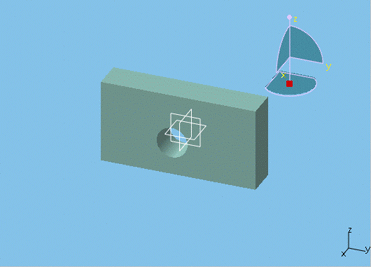
![]() By default, this option is activated.
By default, this option is activated.
Background
Sets background color in all open document windows. Note that the default graduated background color can also be reset by selecting it from the list.
Selected elements, Preselected elements, Low-intensity elements and Preselected element linetype
Set colors of selected elements, preselected elements, low-intensity elements, and the linetype used to display preselected elements.
Note: low intensity elements are elements such as parts,
products, drawings, etc. which can be neither filtered, nor removed. The
default color for low-intensity elements is "dark green" (as indicated in
the picture of the Visualization tab above).
Refer to Preselecting and
Selecting Using the Pointer for a discussion of preselection and
selection techniques.
Update needed
Sets the color of objects to be updated; refer to the Version 5 - Part Design User's Guide for more information about updating objects.
Handles
Sets manipulator handle colors. Graphic manipulators are displayed on certain objects (planar patches, holes, ...) for the purpose of moving the objects more easily. Refer to Moving Objects Using the 3D Compass for more information about how the compass is used on examples of where manipulators are used.
Selected edges
Sets colors of selected edges.
Surface boundaries
If this option is selected, you can set the color and thickness of surface boundaries.
![]() By default, this option is cleared.
By default, this option is cleared.
Smooth Edges
Note that the visualization of smooth edges is defined in the View Mode Customization dialog box.
Depth Display

Display all elements using Z-buffer depth
If this option is selected, it means that the Z-buffer is activated so
that all elements hide each other.
When activated, all elements including lines and planes (usually displayed
in front of other elements) are displayed at their true depth in the 3D
scene. When deactivated, lines and planes are always displayed in front of
other elements.
![]() By default, this option is cleared.
By default, this option is cleared.
Anti-aliasing

Edges/Lines
If this option is selected, it means that anti-aliasing is activated on all edges and lines. It is recommended not to use Full scene when Edges/Lines is activated.
You need then to define the offset coefficient using
the arrows (which are activated once Edges/Lines is selected) to
the right. This offset enables you to enhance the quality of anti-aliasing.
The maximum value you can set is 0.9.
Note that once the offset has been defined, you have to perform a viewing
operation, such as a translation or a rotation, to see the result.
In the example below, the offset has been set to 0.8:
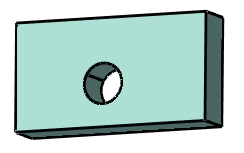
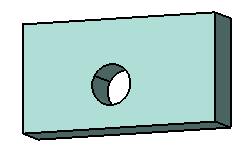
Full scene
If this option is selected, it means that the full scene
super sampling is activated.
Super sampling is a technique used in the
anti-aliasing algorithm.
This technique avoids rendering artifacts, such as the staircase effect,
by improving the
visual quality of lines and surface edges (whether they are common or free
border edges) in the whole scene.
Super sampling means that the image is rendered internally with a
resolution higher than the one on screen. With this technique, each given
pixel on screen is divided into "n" sub-pixels: the more
sub-pixels, the better the result.
You can specify the quality level to be applied by selecting a value from the Super sampling list:
- 2x
Each pixel is divided into 2 sub-pixels. The quality is twice better - 4x
Each pixel is divided into 4 sub-pixels. The quality is four times better - 8x
Each pixel is divided into 8 sub-pixels. The quality is eight times better - 16x
Each pixel is divided into 16 sub-pixels. The quality is 16 times better.
The higher the value, the better the quality but note that
there is a price to pay in performance if you choose a very high quality
level.
4x is a good value to start with because you can
obtain a nice result with a minor impact on performance.
Note that it is recommended not to use Edges/Lines when Full scene is activated.
In the examples below (click the thumbails to enlarge the pictures)
- super sampling is cleared and the staircase effect is clearly visible:
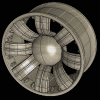
- and when super sampling has been activated and set to 4x:
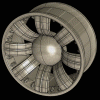
Stereo enable
- On: enables stereoscopic vision
- Off: disables stereoscopic vision.
For more information, refer to Stereoscopic Viewing.
![]() By default, Off is activated.
By default, Off is activated.
Display current scale in parallel mode

The option helps you to know the real size of an object using the following formula:
real size = size on screen / scaling factor
Note that the scale display is automatically refreshed when zooming.
To illustrate this, let's suppose a pad with the following dimensions:
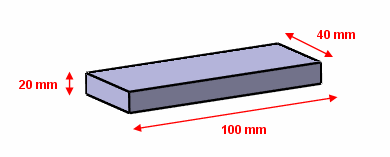
- Display this pad in a parallel view then set the viewpoint so that you see one face of the pad.
- Click On in the Display current scale in parallel mode area.
- Zoom until the scale factor is equal to 2.00. The result should look like this:
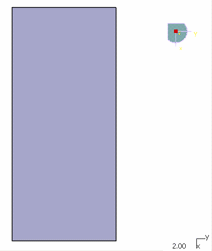
Length = 50 mm (100 mm / 2)
Width = 20 mm (40 mm / 2)
Height = 10 mm (20 mm / 2)
![]() By default, Off is activated.
By default, Off is activated.